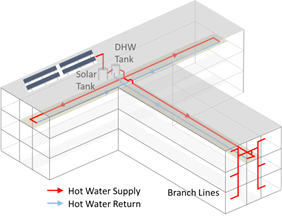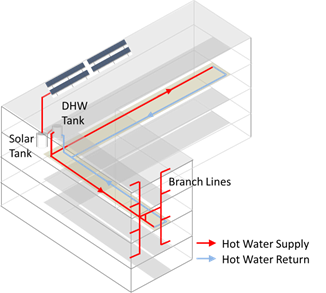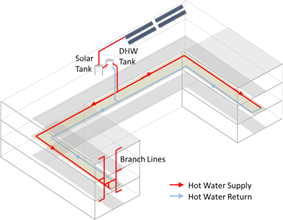

There are three options to comply with the prescriptive water heating requirements for newly constructed single dwelling units. For all three options, the water heater must comply with the mandatory requirements for water heaters. (See Section 5.3.) If a recirculation distribution system is installed, only demand recirculation systems with manual control pumps are allowed. The three options are described below.
Option 1: Install a single 240 volt heat pump water heater. The storage tank shall be located in the garage or conditioned space. In addition, the building must comply with the following:
A compact hot water distribution design meeting the Basic Compact Design in climate zones 1 and 16.
A HERS-verified drain water heat recovery system in climate zone 16.
Option 2: Install a single 240 volt heat pump water heater that meets the requirements of NEEA Advanced Water Heater Specification Tier 3 or higher. For climate zone 16, the storage tank must be located in the garage or conditioned space and install a drain water heat recovery system that meets field verification described in Appendix RA3.6.9.
Option 3: A solar water-heating system with electric backup that meets the installation criteria specified in Reference Residential Appendix RA4.4.20 Solar Water Heating Systems and with a minimum annual solar savings fraction of 0.7.
In Climate Zones 1 & 16, then one or more additional building features must be installed as shown above. These features require consideration at the start of the design process and must be coordinated with several players including the designer, general contractor, sub-contractor, and HERS Rater.
The list of qualified product list of NEEA HPWH can be found here:
https://neea.org/img/documents/qualified-products-list.pdf
For more information on HERS-verified compact hot water distribution design, see Section 5.6.2.4. HERS-verified compact hot water distribution designs are included in Option 1 described above.
For more information on HERS-verified drain water heat recovery system requirements, see Example 5-9 below and Section 5.6.2.5 of this chapter. The Reference Appendix contains the requirements for the proper installation of the system (see RA4.4.21). A HERS-verified drain water heat recovery system is included in Options 1 and 2 described above.
Unless one of the three exceptions can be claimed, any other water heating system that differs from the three options described above does not meet the prescriptive requirements, but can be installed using the performance approach as described in Section 5.5. The three Exceptions are:
A gas or propane instantaneous water heater of up to 200,000 Btu/h and no storage tank may be used in Climate Zones 3, 4, 13, & 14.
An electric instantaneous water heater with point-of-use distribution (RA4.4.5) is allowed in new dwelling units of up to 500 ft2 conditioned floor area
For new dwelling units with 1 or fewer bedrooms, a 120V HPWH may be used instead of a 240V HPWH.
For additions, the prescriptive requirements apply only if a water heater is being installed as part of the addition. In those cases, the prescriptive requirements would apply only to the space that is added, not the entire building.
For alterations where an existing water heater is being replaced, the water heater must meet the mandatory equipment efficiency requirements. Pipe insulation requirements do not apply to inaccessible piping. See Chapter 9 for a more detailed explanation for the water heating alteration requirements.
Example 5-5 − Alterations
Question:
If my house has an electric-resistance water heater and I plan to upgrade my water heater, do I need to install a gas instantaneous or gas storage water heater?
Answer
No, because the existing water heater is an electric water heater, then a consumer electric water heater that meets the requirements of California’s Appliance Efficiency Regulations can replace the existing water heater. If installing new piping to the water heater, then you will need to comply with the mandatory pipe insulation requirements. See Section 5.3.5.1 for more information on pipe insulation requirement and Chapter 9 for more information on alterations.
Example 5-6− Additions
Question:
I am building an addition to my home that will be a self-contained apartment. Do I need to comply with the prescriptive water heater requirements?
Answer:
If the addition will include a water heater, or if it will be connected to the existing hot water distribution system to supply hot water to the apartment, then you must comply with the standards either through the prescriptive or performance path. If taking the performance approach, you can install any type of water heater as long as it 1) meets the requirements of California’s Appliance Efficiency Regulations and 2) does not exceed the water heating energy budget for the self-contained building. If you were adding only an additional room with hot water and not a self-contained dwelling, then the water heating budget would be based on the existing building plus addition. (See Section 5.5.)
Example 5-7 – Heat Pump Water Heaters
Question:
For a new home, can I install an electric water heater? Do I have to perform calculations to show compliance?
Answer:
Yes, electric heat pump water heaters (HPWHs) can be used for both prescriptive and performance compliance. Calculation is not necessary using the prescriptive compliance path. There are 2 prescriptive options (Options 1 and 2 in Section 5.4.1 above) for HPWH. Option 2 is the simplest option, which requires the installation of a NEEA Tier 3 or higher HPWH in the garage or conditioned space. For climate zones 2 through 15, no additional requirement is needed for compliance. For climate zones 1 and 16, compact hot water distribution and/or a drain water heat recovery system are also required, depending on the climate zone. For more details, see Section 5.4.1 above.
For performance compliance, the characteristic of the HPWH must be modeled, such as rated UEF or make and model of the HPWH if it is NEEA rated.
Example 5-8 – Drain Water Heat Recovery
Question:
I’m in the schematic design phase for a single-family home. I intend to include drain water heat recovery in my design and to follow the prescriptive path. What are the primary design issues I should consider?
Answer:
If you follow the prescriptive path, drain water heat recovery is required in climate zones 1 and 16. For all other water heater types, you could follow the performance path and obtain compliance credit within an energy model calculation. In any case, the initial design issues are related to the selection of an appropriate drain water heat recovery model (i.e. horizontal or vertical type, minimum rated effectiveness, and diameter and length), and designing the layout of the system. If your residence is single story, then a horizontally rated unit is required. If your residence has multiple stories, then the unit can be horizontally or vertically rated. In any case, the required minimum rated effectiveness is 42 percent. The diameter of the unit should match the diameter of the drainpipe. Added length improves effectiveness but requires more space. In terms of the system layout, the unit must recover heat from at least the master bathroom shower and must at least transfer that heat either back to all the respective showers or the water heater. If you desire to maximize savings, you should place the unit in a drain line that serves all the showers, and you should pipe the preheated water to the cold side of all the shower mixing valves and the make-up water inlet of the water heater. This is known as an equal flow configuration (see Figure 5-3), since the preheated water flow rate will match the drain water flow rate.

The prescriptive requirement for domestic hot water systems with recirculation distribution systems requires the installation of a demand recirculation control to minimize pump operation and heat loss from pipes. Demand controls for recirculation systems operate by sensing hot water demand and recirculation return temperatures. The temperature sensor should be installed at the farthest end of the recirculation loop close to the last branch pipe.
Any system not meeting these prescriptive requirements must instead meet the standard design building energy budget that is established by the energy efficiency performance of a HPWH or gas instantaneous water heater that meets the requirements of California’s Title 20 Appliance Efficiency Regulations or must follow the performance compliance method for the building as a whole.